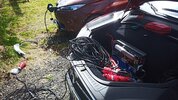They are in Finland. 230V is a single phase and will be necessary to run all the equipment in the trailer.
I was thinking of something more like the Ecoflow Delta 2, or the Bluetti AC200MAX. A battery, charger, and inverter all rolled in to one, without having to do any the integration work or find the room for all that equipment. Those two will charge from multiple sources at once, so they could even have solar panels added while still drawing 100W from the car if needed. Both are also made in 230V EU versions. There are bigger units available if you want more backup time or to run a larger cooker than 1500W as well.
Ecoflow Delta 2 seems to be only 999€ and is easily available in all stores here. That does indeed sound like a very good choice, and very useful for many other purposes as well to be used instead of gasoline generator etc.
1800W constant output, 2700W peak. Only 1kWh battery but can be extended if needed, and actually I think 1kWh is quite enough.
Only downsides: max 10A charging from 12V, and also 12V input shares connector with solar panel input so can't hook up both. But solar panels might be a waste of money anyway, can't fit that many to the trailer and a few kwh per day seems useless when there's an EV parked next to it..
Edit: custom setup as suggested by @n2mb_racing is not of the question. In fact I have a 23kWh home battery ("powerwall") built from an old Think City lithium pack, hooked up to Deye grid-tied inverter. I built the BMS and all controlling electronics myself, around a Raspberry Pi.. So a complex setup is not an issue.
Last edited:




